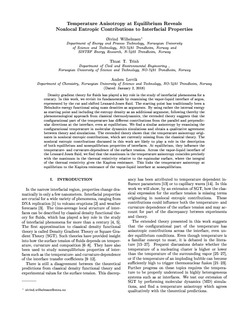| dc.contributor.author | Wilhelmsen, Øivind | |
| dc.contributor.author | Trinh, Thuat | |
| dc.contributor.author | Lervik, Anders | |
| dc.date.accessioned | 2018-04-12T08:24:58Z | |
| dc.date.available | 2018-04-12T08:24:58Z | |
| dc.date.created | 2018-01-08T10:37:51Z | |
| dc.date.issued | 2018 | |
| dc.identifier.issn | 1063-651X | |
| dc.identifier.uri | http://hdl.handle.net/11250/2493776 | |
| dc.description.abstract | Density gradient theory for fluids has played a key role in the study of interfacial phenomena for a century. In this work, we revisit its fundamentals by examining the vapor-liquid interface of argon, represented by the cut and shifted Lennard-Jones fluid. The starting point has traditionally been a Helmholtz energy functional using mass densities as arguments. By using rather the internal energy as starting point and including the entropy density as an additional argument, following thereby the phenomenological approach from classical thermodynamics, the extended theory suggests that the configurational part of the temperature has different contributions from the parallel and perpendicular directions at the interface, even at equilibrium. We find a similar anisotropy by examining the configurational temperature in molecular dynamics simulations and obtain a qualitative agreement between theory and simulations. The extended theory shows that the temperature anisotropy originates in nonlocal entropic contributions, which are currently missing from the classical theory. The nonlocal entropic contributions discussed in this work are likely to play a role in the description of both equilibrium and nonequilibrium properties of interfaces. At equilibrium, they influence the temperature- and curvature-dependence of the surface tension. Across the vapor-liquid interface of the Lennard Jones fluid, we find that the maximum in the temperature anisotropy coincides precisely with the maximum in the thermal resistivity relative to the equimolar surface, where the integral of the thermal resistivity gives the Kapitza resistance. This links the temperature anisotropy at equilibrium to the Kapitza resistance of the vapor-liquid interface at nonequilibrium. | nb_NO |
| dc.language.iso | eng | nb_NO |
| dc.publisher | American Physical Society | nb_NO |
| dc.title | Temperature anisotropy at equilibrium reveals nonlocal entropic contributions to interfacial properties | nb_NO |
| dc.type | Journal article | nb_NO |
| dc.description.version | submittedVersion | nb_NO |
| dc.source.volume | 97 | nb_NO |
| dc.source.journal | Physical Review E. Statistical, Nonlinear, and Soft Matter Physics | nb_NO |
| dc.source.issue | 1 | nb_NO |
| dc.identifier.cristin | 1537420 | |
| dc.description.localcode | This is a submitted manuscript of an article published by American Physical Society in Physical review. E, 18 January 2018 | nb_NO |
| cristin.unitcode | 194,64,25,0 | |
| cristin.unitcode | 194,64,91,0 | |
| cristin.unitcode | 194,66,25,0 | |
| cristin.unitname | Institutt for energi- og prosessteknikk | |
| cristin.unitname | Institutt for bygg- og miljøteknikk | |
| cristin.unitname | Institutt for kjemi | |
| cristin.ispublished | true | |
| cristin.fulltext | preprint | |
| cristin.qualitycode | 0 | |
